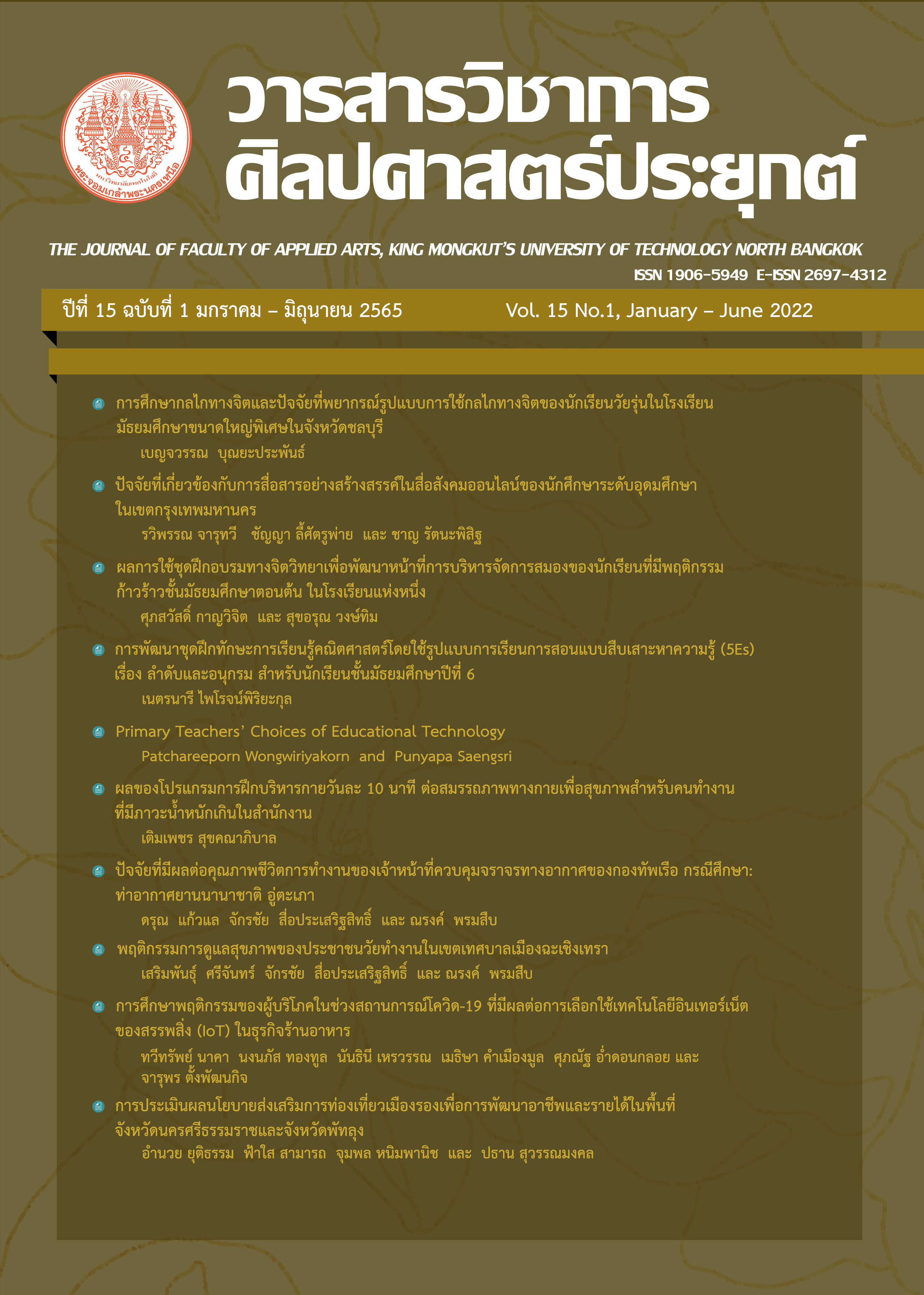การศึกษาการเลือกใช้เทคโนโลยีของครูประถมศึกษา
Main Article Content
บทคัดย่อ
การศึกษานี้มีวัตถุประสงค์เพื่อ 1) ศึกษาเทคโนโลยีที่นำมาใช้ในการจัดการเรียนการสอนวิชาภาษาอังกฤษ 2) ศึกษาเหตุผลสำหรับการเลือกใช้เทคโนโลยีทางการศึกษาของครูผู้สอนวิชาภาษาอังกฤษในระดับประถมศึกษา เครื่องมือที่ใช้ในการศึกษาคือ แบบสัมภาษณ์กึ่งโครงสร้าง กลุ่มตัวอย่างคือ ครูผู้สอนวิชาภาษาอังกฤษ โรงเรียนวัดพระปฐมเจดีย์ จังหวัดนครปฐม จำนวน 7 คน โดยใช้การนับความถี่และการวิเคราะห์แก่นสาระในการวิเคราะห์ข้อมูลผลการศึกษาพบว่า 1) ครูผู้สอนวิชาภาษาอังกฤษทุกคนเลือกใช้โทรทัศน์ คอมพิวเตอร์ และยูทูปในการจัด การเรียนการสอน 2) เหตุผลหลักสำหรับการเลือกใช้เทคโนโลยีทางการศึกษาต่างๆ เพราะช่วยส่งเสริมการจัดการเรียนรู้ของครูผู้สอน และเป็นการตัดสินใจของสถาบันการศึกษา
Article Details

อนุญาตภายใต้เงื่อนไข Creative Commons Attribution-NonCommercial-NoDerivatives 4.0 International License.
1.บทความที่ตีพิมพ์เป็นลิขสิทธิ์ของวารสารวิชาการศิลปศาสตร์ประยุกต์ การนำเนื้อหา ข้อความหรือข้อคิดเห็น รูปภาพ ตาราง ของบทความไปจัดพิมพ์เผยแพร่ในรูปแบบ ต่าง ๆ เพื่อใช้ประโยชน์ในเชิงพาณิชย์ ต้องได้รับอนุญาตจากกองบรรณาธิการวารสารอย่างเป็นลายลักษณ์อักษร
2.ข้อความที่ปรากฏในบทความแต่ละเรื่อง เป็นความคิดเห็นส่วนตัวของผู้เขียนแต่ละท่านไม่เกี่ยวข้องกับวารสารวิชาการศิลปศาสตร์ประยุกต์ และบุคลากร คณาจารย์ท่านอื่น ๆ ในวารสารฯ แต่อย่างใด ความรับผิดชอบองค์ประกอบทั้งหมดของบทความแต่ละเรื่องเป็นของผู้เขียนแต่ละท่าน หากมีความผิดพลาดใด ๆ ผู้เขียนแต่ละท่านจะรับผิดชอบบทความของตนเองแต่ผู้เดียว
เอกสารอ้างอิง
Bauer, J., & Kenton, J. (2005). Toward technology integration in the schools: Why it isn’t happening. Journal of Technology and Teacher Education, 13(4), 519-546.
Balas, P. (2020). Significant of smartphone: An educational technology tool for teaching and learning. International Journal of Innovative Science and Research Technology, 5(5), 1634-1638
Clements, D. H. (1994). The uniqueness of the computer as a learning tool: Insights from research and practice, In Young children: Active learners in a technological age, J. L. Wright & D. D. Shade (Eds.), Washington, DC: NAEYC.
Kumari, M. M. (2020). Educational technology: Advanced way of learning. Supporting Teaching Learning at School. Lucknow: Book Rivers.
Lazar, S. (2015). The importance of educational technology in teaching. International Journal of Cognitive Research in Science, Engineering and Education, 3(1), 111-114.
Lewis, G. (2004). The internet and young learners. Oxford: Oxford University Press.
Lo, J. J. (2013). E-learning readiness in senior high school in Banda Aceh, Indonesia. Journal of Information Technology and Applications, 7(4), 122-132.
Maddux, C. D., Johnson, D. L., & Willis J. W. (2001). Educational computing learning with tomorrow’s technologies (3rd ed.). Needham Heights, MA: Allyn and Bacon, 95-122.
Office of the Basic Education Commission. (2008). Basic education core curriculum B.E. 2551 (A.D. 2008). Bangkok: Ministry of Education.
Schoepp, K. W. (2004). Technology integration barriers in a technology-rich environment: A CBAM perspective (Unpublished master’s thesis), University of Calgary, Alberta.
Stockwell, G. (2007). A review of technology choice for teaching language skills and areas in the CALL literature. ReCALL: the Journal of EUROCALL, 19(2), 105.
Sulaimani, A. O., Sarhandi, P. S. A., & Buledi, M. H. (2017). Impact of CALL in-house professional development training on teachers’ pedagogy: An evaluative study. Cogent Education, 4(1), 1-12.
Syathroh, I. L. (2020). A study on Indonesian teachers’ use of technology in English language teaching. Journal of Educational Experts (JEE), 3(1), 1-12.
Szeto, E., & Cheng, A. Y. N. (2017). Pedagogies across subjects: What are preservice teachers’ TPACK patterns of integrating technology in practice? Journal of Educational Computing Research, 55(3), 346-373.
Watson Todd, R. W. (2020). Teachers’ perceptions of the shift from the classroom to online teaching. International Journal of TESOL Studies, 2(2), 4-17.


